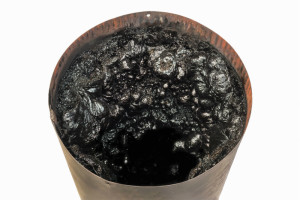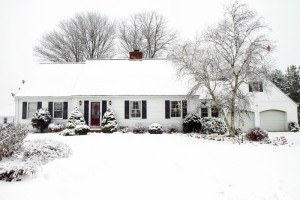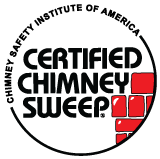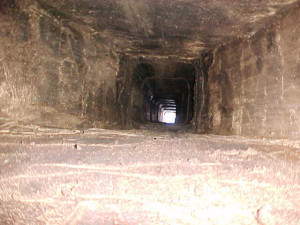by Billy Sweet | Feb 28, 2018 | Smoke Chamber
The smoke chamber is an important part of the fireplace and chimney system, because it helps the smoke find its way up the flue. The space where you see the fire burning is the firebox. The smoke rises up, and the next place you see it is the top of the flue. No one sees what goes on behind the scenes, but just above the firebox and below the flue is the smoke chamber, which is essential for an efficient chimney.
The Smoke Chamber’s Job
The smoke chamber consists of a slanted wall to direct the smoke up, and a shelf, called a smoke shelf, that keeps the smoke from falling back into the firebox. While the smoke is in the smoke chamber, the hot air, gases, and smoke mix together before rising up the chimney. Since heat rises, it assists the rest of the smoke in pushing up the chimney.
Maintaining the Smoke Chamber
Just like the rest of the chimney system, the smoke chamber should be maintained in order to be safe and efficient over time. According to the National Fire Protection Association (NFPA), the smoke chamber should be parged smooth with a refractory insulated mortar mix, which directs the air across a smooth surface, while protecting the masonry from high heat. Even if your smoke chamber has never been parged, you can likely restore it to code compliance by scheduling a smoke chamber parge.
If you have an older fireplace, your smoke chamber may have tiered brick steps that form the smoke chamber. This may have worked for years, but it is far less efficient than a smoothly parged wall. The multiple joints and bricks of a non-parged smoke chamber can allow soot and creosote buildup. This slows air, making the rest of the chimney less efficient.
Hire a Professional
You don’t have to hire a master mason to parge your smoke chamber, but it’s definitely to your benefit to hire a certified chimney sweep. Billy Sweet Chimney Sweeps are CSIA-certified and experienced in restoring chimney systems to proper function. Whether your smoke chamber needs a simple repair, or if it’s never been parged before, we’ll take care of your chimney, and you’ll be surprised with how well it works. Parging the smoke chamber raises efficiency, generates less heat lost up the chimney, and requires fewer chimney sweeps than other systems. A more efficient system means less likelihood of a flue fire, less wood wasted to reach the desired temperature, and less necessary maintenance.
If you have not had your chimney inspected in the last 12 months, now is the time to do so. You may need to have your chimney cleaned, parts replaced, or your smoke chamber may need to be parged. Without scheduling an appointment with a chimney expert, you will never know.
Contact Billy Sweet Chimney Sweep today. Call 617-469-4528 or schedule an appointment online.
by Billy Sweet | Dec 26, 2015 | Creosote
If you have a fireplace, you likely know that creosote can be a hazard to your home and family. You probably also have your fireplace swept by a certified chimney sweep each year to remove any creosote buildup from your chimney, and perhaps you even burn the occasional creosote sweeping log to help maintain your chimney. But how much do you know about creosote, how it forms, the dangers it poses and how you can keep it at bay? We’ve put together some basic information on creosote so you can better protect your home and family.

What is creosote?
As smoke from your fireplace makes its way to the top of your chimney, it cools. As the smoke cools, it causes condensation of the chemicals and water vapor created when wood burns. The substance left sticking to your walls is creosote. All forms of creosote — whether black or brown, sticky or shiny, hard or tar like — can be found sticking to the insides of most chimneys.
Why is creosote dangerous?
As little as a quarter inch of creosote buildup on the walls of your chimney can be dangerous, putting your home at risk of a chimney fire. Highly combustible, creosote can burst into flames if it is touched by a stray spark from your fireplace, or if chimney temperatures exceed 1,000 degrees. If creosote builds up enough in your chimney, it also can prevent the gases created by the fireplace from exiting your home, which can force dangerous carbon monoxide back into your home.
How can I avoid the dangers of creosote?
Using the right wood in your fireplace can slow the buildup of creosote in your chimney. Only burn dry hardwoods that have been seasoned for a minimum of six months. When wood is improperly seasoned and contains moisture, it produces more water vapor when burned and burns at a cooler temperature, which causes the formation of creosote. Make sure that your fire is large enough for your fireplace. If your logs are too small, the fire won’t burn hot enough for your chimney. Your flue also should be fully opened when you’re burning a fire, as a partially closed flue will cause smoke to remain in your flue longer, encouraging creosote buildup.
Of course, the best way to keep your home safe from a creosote fire is to have your chimney swept and inspected each year by a certified chimney sweep. Your chimney sweep will make sure that your chimney is entirely creosote free. During the sweep’s inspection, he also will make sure your chimney does not show any signs of damage from a past creosote fire, which can weaken your chimney and put your home at danger for a future fire.
If you’re overdue for a chimney sweeping and inspection, don’t wait! Putting off your chimney sweeping puts your home and family in danger of a creosote-caused chimney fire or carbon monoxide poisoning. Call the certified sweeps at Billy Sweet to have your chimney ready for the fire-burning season.
by Billy Sweet | Dec 13, 2015 | Winter Storm Fireplace
In Boston, we are used to heavy snowstorms and blizzards during the winter. In January and February of 2015, we experienced a blizzard that lasted over six weeks and dumped a record 108.6 inches of snow in our area. Even though long-time residents know how to be ready for these types of storms, Billy Sweet Chimney Sweep would like to remind you of how you can prepare your fireplace so that you will not have to worry about being without heat when the power goes out during a blizzard.

Schedule a professional chimney sweeping and inspection before winter arrives.
This maintenance task will take care of removing all of the accumulated creosote from the inner walls of your chimney, which increases fireplace safety and reduces fire hazards. During the inspection, our Chimney Safety Institute of America (CSIA)-certified chimney sweeps will examine the condition of your fireplace and chimney to be sure everything is working safely. If we find any damage, we will make recommendations of the repairs that are necessary for you to use your fireplace safely.
Check the gaskets to see if they need to be repaired or replaced.
You want to ensure that the gaskets on your fireplace doors, damper, and ash dump are providing an effective seal. According to Cabin Living, without a proper seal, too much air can leak into the firebox and cause overfire and permanent damage to your fireplace.
Have the blower cleaned.
If your fireplace is equipped with a blower, you should clean off the dust and dirt from it to protect the balance of the blower. When the blower has too much dust accumulation on its blades, the balance can change and cause the bearings to wear out prematurely. Your fireplace blower typically will not have a filter to keep dust off, so you need to check it regularly to be sure it is clean.
Replace broken or deteriorated bricks in the lining.
When the brick lining is so damaged that it has deteriorated so much that the steel body of the firebox is exposed, the high temperatures can lead to permanent damage. Be sure the bricks are in good shape so you will not have to worry about damage occurring that could make your fireplace unsafe.
Billy Sweet Chimney Sweep is here to help you prepare your fireplace for dangerous storms this winter. Contact us to schedule an appointment for a chimney sweeping and inspection so that you can stay warm and safe this winter.
by Billy Sweet | Nov 12, 2015 | CSIA Certification
When faced with deciding who is actually right and qualified for a job, it is important to look at the certifications of the company and their employees before settling. That mindset applies to doctors and dentists, and it certainly applies to chimney sweeps. In our field, receiving a CSIA (Chimney Safety Institute of America) certification not only gives us the best training in properly cleaning your chimney, it also educates on the best responses to worst-case scenarios like carbon monoxide and chimney fires. Knowing that your chimney sweep has the best qualifications will make Billy Sweet Chimney Sweep the easiest choice for you!

What we do as a profession was largely unregulated until 1983, when the CSIA was founded. This not for profit organization aims to educate not only those in our field, but also the public on how to maintain and correct any hazards their chimney or venting system may present over time. To become certified, there are two exams based on a comprehensive review time that can happen in person or online. Once those exams are completed thoroughly, a code of ethics is signed to ensure that sweeps can be trusted with the public’s safety. That also is tested through educational classes that discuss upcoming technologies and hard to grasp concepts, like physics through a certified sweep’s entire career.
The CSIA has several goals for their chimney sweeps including the need to fully eliminate any chimney related hazards that could threaten property, pets, and especially human lives. These hazards could come from carbon monoxide or chimney fires from creosote buildup. As certified chimney sweeps, we have several areas of knowledge that are all connected to the main purpose of prevention and education. Besides the basic practice of what we do, cleaning and inspecting chimneys and venting systems, we also involve ourselves with all the minutiae. Knowing all the factors and physics in the development of creosote, as well as the requirements from the EPA (Environmental Protection Agency) easily separate CSIA certified professionals from the companies that simply have the physical tools for the job. Our continuous education on a comprehensive list of subjects gives us confidence in our practice as well as in our sharing of that knowledge with our customers. We want our clientele to know what to expect from their chimney sweep, and we embrace the challenge to aim higher and know more!
We want anyone looking for a chimney sweep to look first at those that are CSIA certified. Not only are they more educated on what’s important, but they also care more about the home and people that are associated with the chimney. Thank you so much for choosing Billy Sweet Chimney Sweep as your CSIA certified sweeps for over 30 years!
by Billy Sweet | Aug 13, 2015 | Chimney Video Inspection
During a routine chimney inspection, it is difficult to understand fully what takes place as your chimney sweep explores the inner and outer cracks and crevices of your fireplace. Here at Billy Sweet Chimney Sweep, we don’t depend solely on a flashlight and a gut feeling like many sweeps do. We use the most updated technology available: a full video inspection of the innards of your chimney to ensure it is in the best shape it can be in for the upcoming fall and winter seasons.

Why is a video inspection needed?
According to the National Fire Protection Association (NFPA) and the Chimney Safety Institute of America (CSIA), a level one inspection of a chimney requires not much more than common tools and a flashlight to look at the basic structure and condition of your chimney. It is a straightforward exam at first glance. Looking for cracks that may have developed due to temperature and water level fluctuations in the masonry, as well as any excess condensation or creosote buildup is all part of the normal examination. The reason for a video inspection is simple: The camera can look at areas of your chimney that a flashlight, and therefore human eyes, are not able to. Using the Chim-Scan camera system and Wohler Vis2000-Pro, cracks and leaks, as well as presence of excess soot or other debris, are easily identified and addressed, whereas a flashlight’s beam may not make fully aware the issue.
When should I get it inspected?
Now is the time. The status of your chimney is very important to us and it is necessary to get it swept and inspected before it becomes starts being of use in the cooler months. Leaving buildup and cracks from the previous seasons can be a safety hazard as well as harmful to your chimney’s lifespan in the long-term.
Regardless of the nature of the appointment with us, we will inspect every chimney with our camera system because we want everyone to have peace of mind when it comes to the safety of the entire family. Testing for carbon monoxide is a standard practice for us, and one that we will do free of charge at every inspection. We care about your safety and we will go the extra step, every time.




